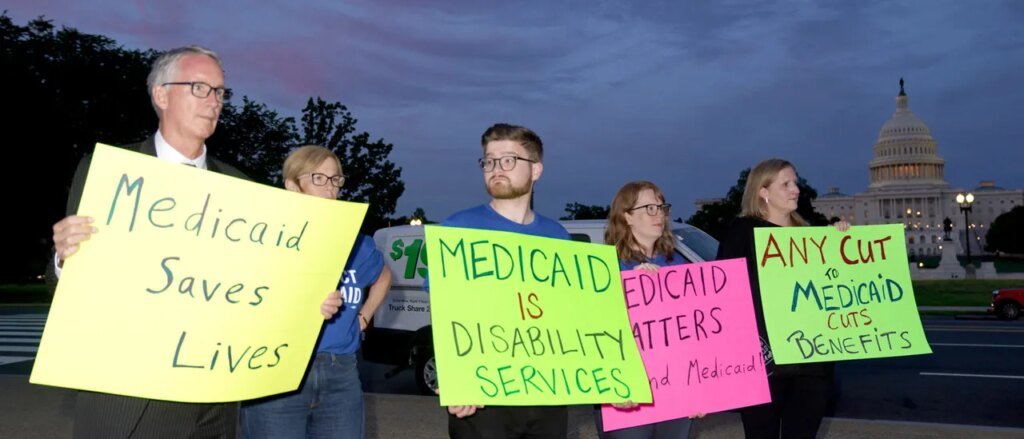Democrats have criticized new Medicaid provisions in a significant Republican bill, labeling them as “Draconian.” However, an examination of the policy changes indicates that they are actually quite moderate, despite the intense rhetoric.
President Donald Trump enacted this legislation on July 4th, which is part of a broader GOP tax and spending initiative expected to yield over $1 trillion in savings through Medicaid reform. While Democrats present this overhaul as a major threat to healthcare, they overlook the remarkable increase in Medicaid spending over the past decade. The reforms primarily aim to address various funding loopholes and issues surrounding enrollment.
Nina Oakalenko Schaefer, who leads the Heritage Foundation’s Center for Health and Welfare Policy, remarked on the left’s fear-based narrative. She suggested that the proposed adjustments are designed to strengthen Medicaid’s existing framework, combat fraud, waste, and elevate overall system efficiency.
Democrats have seized the issue of Medicaid as pivotal ahead of the midterm elections. GOP reforms are framed as jeopardizing healthcare for vulnerable populations. House Minority Leader Hakeem Jeffries called the new law “the biggest attack on Medicaid and healthcare in American history,” with others claiming it could lead to lives lost as a direct result of these changes.
Yet, experts argue that such claims are misleading. Medicaid expenditures are projected to rise over the next decade, although at a slower pace than earlier forecasts predicted.
Hayden Dublois, from the Government Accountability Foundation, indicated that what the left describes as drastic cuts are not quite accurate. While Medicaid spending will increase during budget cycles, it will simply be less than what was previously anticipated.
Jeremy Nigohosian, an economist at the Competitive Enterprise Institute, highlighted that current Medicaid spending has surged by 51% compared to 2019. He expressed disbelief at criticisms regarding the supposed severity of cuts, urging critics to consider the rapid growth experienced in recent years. In light of that, he feels that the modifications in the new bill are not excessive.
Interestingly, just a day before the legislation was passed, a rural hospital in Nebraska announced its closure, citing anticipated federal budget cuts related to Medicaid. Senator Bernie Sanders expressed concerns about “terrifying reductions,” suggesting this would not be the last hospital affected.
However, some reforms criticized, like the crackdown on the “provider tax,” are seen as measures to mitigate how some states inflate Medicaid expenses to gain extra federal funding. These changes will not take effect until 2028.
Provider taxes have allowed states to receive higher subsidies through inflated Medicaid costs, essentially redistributing taxpayer funds back into the system. Dublois criticized this, suggesting it functions as legalized money laundering.
The federal government generally prohibits such funding recycling, although states can comply with rules ensuring their provider tax does not exceed 6% of net patient income. New regulations are set to lower the federal threshold from 6% to 3.5%, which could help curb these practices.
Some governors have loudly warned about the potential impacts of the new law, pointing out that states have financed a larger share of Medicaid in the past. If they wish to lessen the effect of federal changes, Nigohosian believes they have the budgetary capability to do so.
Another contentious element is the new Medicaid work requirements. Beginning in 2027, states will need to track adult Medicaid recipients, ensuring they fulfill at least 80 hours of work, volunteering, or education per month.
Democrats, like Rep. Frank Pallone from New Jersey, argue that such bureaucratic demands could result in millions of Americans losing their medical coverage and succumbing to illness. They caution that states may struggle to implement such tracking systems.
Nonetheless, Dublois assures that there is ample time to set up these requirements, mentioning available funds and guidance from the Centers for Medicare and Medicaid Services to aid states with compliance.
Data obtained by the FGA indicates that 62% of Medicaid recipients are not healthy and inactive. The American Enterprise Institute noted in May that many recipients, who aren’t working, spend considerable time on leisure activities, exceeding their required work hours.
Ultimately, Schaefer argued that the practical aspects of the bill could be hard for critics to dispute. Concerns seem to stem from a reluctance to confront necessary changes. Many wish to maintain the status quo, ignoring the substantial financial burden from programs serving low-income populations.
















